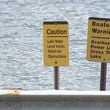SEOUL, South Korea (AP) — North Korea test-fired two ballistic missile Monday but one of them possibly flew abnormally, South Korea's military said, a day after the North vowed "offensive and overwhelming" responses to a new U.S. military drill with South Korea and Japan.
The Joint Chiefs of Staff said in a statement the missiles were launched 10 minutes apart in a northeasterly direction from the town of Jangyon in southeastern North Korea.
It said the first missile flew 600 kilometers (370 miles) and the second missile 120 kilometers (75 miles), but didn’t say where they landed. North Korea typically test-fires missiles toward its eastern waters, but the second missile’s flight distance was too short to reach those waters.
Joint Chiefs of Staff spokesperson Lee Sung Joon later told a briefing the second missile suffered a possible abnormal flight during the initial stage of its flight. He said if the missile exploded, its debris would likely have scattered on the ground though no damages was immediately reported. Lee said an additional analysis of the second missile launch was under way.
South Korean media, citing unidentified South Korean military sources, reported that it was highly likely the second missile crashed in an inland area of the North. The reports said the first missile landed in the waters off the North’s eastern city of Chongjin.
The Joint Chiefs of Staff condemned the North's launches as a provocation that poses a serious threat to peace on the Korean Peninsula. It said South Korea maintains a firm readiness to repel any provocations by North Korea in conjunctions with the military alliance with the United States.
The launches came two days after South Korea, the U.S. and Japan ended their new multidomain trilateral drills in the region. In recent years, the three countries have been expanding their trilateral security partnership to better cope with North Korea’s evolving nuclear threats and China’s increasing assertiveness in the region.
The “Freedom Edge” drill was meant to increase the sophistication of previous exercises with simultaneous air and naval drills geared toward improving joint ballistic-missile defense, anti-submarine warfare, surveillance and other skills and capabilities. The three-day drill involved a U.S. aircraft carrier as well as destroyers, fighter jets and helicopters from the three countries.
On Sunday, North Korea’s Foreign Ministry issued a lengthy statement strongly denouncing the “Freedom Edge” drill, calling the U.S.-South Korea-Japan partnership an Asian version of NATO. It said the drill openly destroyed the security environment on the Korean Peninsula and contained a U.S. intention to lay siege to China and exert pressure on Russia.
The statement said North Korea will “firmly defend the sovereignty, security and interests of the state and peace in the region through offensive and overwhelming countermeasures.”
Monday's launches were the North's first weapons firing in five days. On Wednesday, North Korea launched what it called a multiwarhead missile in the first known test of a developmental, advanced weapon meant to defeat U.S. and South Korean missile defenses. North Korea said the launch was successful, but South Korea dismissed the North's claim as deception to cover up a failed launch.
In recent weeks, North Korea has floated numerous trash-carrying balloons toward South Korea in what it has described as a tit-for-tat response to South Korean activists sending political leaflets via their own balloons. Last month, North Korea and Russia also struck a deal vowing mutual defense assistance if either is attacked, a major defense pact that raised worries that it could embolden Kim to launch more provocations at South Korea.
Meanwhile, North Korea opened a key ruling party meeting Friday to determine what it called “important, immediate issues” related to works to further enhance Korean-style socialism. Observers said the meeting was continuing Monday.
Credit: AP
Credit: AP
Credit: AP
Credit: AP
Credit: AP
Credit: AP
Credit: AP
Credit: AP











